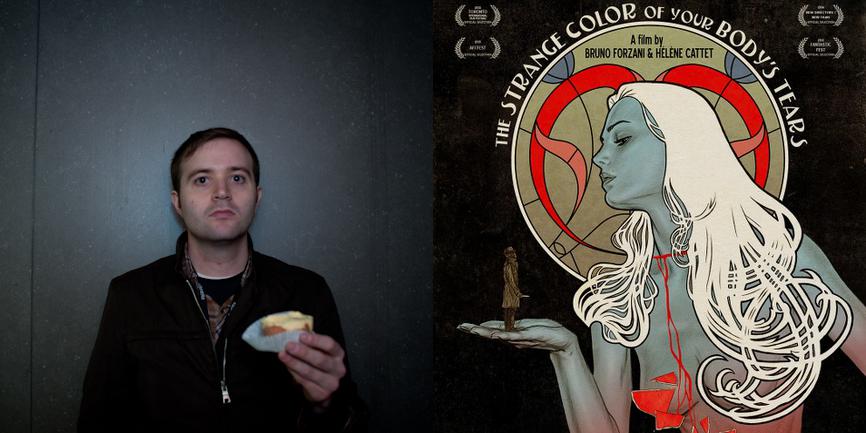Warning: Spoilers ahead
Alleluia, the latest audacity from Belgian auteur Fabrice Du Welz, is a remake of sorts of the American cult film The Honeymoon Killers (1969), directed by American opera composer Leonard Kastle, who might have been an auteur save for the fact that he wrote and directed only one film. (Martin Scorsese was famously fired as director of The Honeymoon Killers for working too slowly.) Both movies are based on the same true-life crime case: the bizarre story of Martha Beck and Raymond Fernandez, the infamous serial-killer couple who may have murdered as many as 20 women in the late ’40s by meeting their victims through lonely-hearts ads, Fernandez romancing and marrying the victim, Beck accompanying him as his ersatz sister. Although this lurid tale has been told twice cinematically between these two versions – Deep Crimson (1996) and Lonely Hearts (2006) – a comparison of the earlier American classic with the most recent European art film, produced 45 years apart, makes for an interesting study in modern styles of horror. Both films are brutal and fascinating, but in distinctly different ways; one is arguably more politically subversive than the other.
Fabrice Du Welz first made an international splash in 2004 with Calvaire, a Belgian “Southern Gothic” that makes Walter Hill’s brilliant Southern Comfort, to which it owes a big debt, look like a Gidget movie. (In Southern Comfort, the locals kill pigs, and Hill controversially used actual footage of Cajuns killing wild boars; in Calvaire, they fuck them, which was presumably simulated, but you never know with Du Welz.)
Laurent Lucas, who plays the feminized, sexually victimized protagonist of Calvaire, returns in Alleluia as Michel, the murderous, masculine and manipulative victimizer, based on Ray Fernandez. In The Honeymoon Killers, the great Tony Lo Bianco plays Fernandez as a Latin Lothario, suave and oleaginous, a caricature of the real-life killer, and without any backstory. Du Welz presents the same character closer to reality, referencing Fernandez’s severe head injury, which may have influenced his criminal behavior, and the black magic he used, which he believed made him irresistible to women. Similarly, Du Welz has Lola Dueñas, an Almodóvar regular, play her character, Gloria, much closer to the real Martha Beck, if you disregard her not being zaftig.
Alleluia starts with a scene of Gloria sponging down a corpse, a reference to Beck’s first job: an undertaker’s assistant who prepared female bodies for burial. Gloria has a daughter she leaves with a friend and abandons to pursue her murderous spree with Fernandez, much like the real-life character. In The Honeymoon Killers, Martha Beck (played by the wonderful Shirley Stoler) is an administrative nurse with no children; instead, she deposits her infirm mother in a nursing home before embarking on her nefarious adventure. The verisimilitude of Alleluia, although brilliantly subverted in a number of surrealistic scenes, is in stark contrast to the campy, romantic spirit of The Honeymoon Killers, which lends it more allegorical, even political, overtones, and makes its brutality all the more brutal. As I’ve argued elsewhere, the best camp is always highly political in its own way.
The aspect of the true-life story that is perhaps most notably changed in Alleluia is the inversion of the Latin character – Martha Beck being played as and by a Latina, Fernandez as and by a Caucasian. (The real Fernandez was American-born of Spanish parents). It’s a significant shift, portraying the unhinged and psychotic female who drives the murders as a “foreigner,” playing both on Latin stereotypes (the jealous, passionate, and sexually voracious female) and on contemporary issues of European xenophobia (she literally wants to usurp the property and life of their final, extremely wealthy, Belgian victim). In The Honeymoon Killers, Shirley Stoler, as the fat, bossy nurse, couldn’t be more exemplary of the U.S.A. in her capitalist aspirationalism and ambition, her love of bon-bons neatly reinforcing her extravagant desires. (In one scene, she luxuriously traces her finger over the candy map before choosing a chocolate like a destination.) Although both films are told largely from the female protagonist’s point of view, in Alleluia she is fiery and foreign, in The Honeymoon Killers she is businesslike and quintessentially domestic, a monster that is very much a product of the very country it terrorizes.
In other words, Du Welz interprets a thoroughly American story through a very European lens, both thematically and stylistically. (As I mentioned, Calvaire is essentially a Southern Gothic, a very particular American genre.) As with many European auteurs, from Godard to Herzog to Fassbinder and beyond, American mythology and classic film are both exalted and deflated; they are equally ambivalent toward and seduced by them. In Alleluia, Michel is obsessed with The African Queen; after disposing of one of their victims, he takes Gloria to see John Huston’s film in a theatre, later imitating Bogart’s imitations of wild animals from the movie to calm her down and make her laugh. (Du Welz in fact dedicates Alleluia at the end to Bogart and Huston.)
Instead of ultimately making his hyper-violent tale cautionary, however, Du Welz indulges in the amoral and sexually exploitative violence of his American-inspired characters, and is to some degree seduced by the aesthetics of torture porn. If The Honeymoon Killers operates satirically as a savage critique of American values, Alleluia tends more to indulge them. Significantly, the most major departure in Du Welz’s version of Fernandez and Beck is that they actually get away with murder, partying in the end at some Eurotrash performance/art bar called Lux, the characters technically available for a sequel. In Kastle’s film, as in real life, they wind up in electric chairs, with no franchise potential.
Nonetheless, Du Welz is undeniably a remarkably distinctive and ingenious auteur. He has a sensibility and a set of visual motifs like no other: his violent cropping of faces and bodies, as if his mise-en-scène is participating in the violence he depicts; his masterful use of slow-motion and abstract imagery as transitional devices; his ability to extract visceral, insanely committed performances from his actors, whose emotional range and depth force the audience into an ambivalent identification with even the most monstrous of characters. Du Welz’s sense of the surreal is unique; anyone who has seen the hillbilly dance sequence in Calvaire can attest to that. In one memorable scene in Alleluia, Gloria, in a static long shot, sings of her profound and undying love for Michel directly to the camera, standing beside the naked body of their latest victim luridly laid out on the kitchen table, before proceeding to saw off her foot with a hacksaw. It’s a bold discursive device, poetic and disruptive, that deepens the audience’s emotional response rather than alienating it. Another scene, involving a subjective camera and expressionistic flashbacks that Gloria has after having been drugged by Michel, ends up in her witnessing a perverse and surrealistic family game of Twister between Michel, his latest wife, and her young daughter, a twisted representation of Freud’s concept of family romance.
Du Welz is also adept at the blackest of humor, as in the scene in which Gloria has a hysterical fit of laughter, which she successfully passes off as crying, while her husband hoodwinks their latest victim into believing a cover story about the pair having been Christian missionaries in Africa. Coming from predominantly Catholic Belgium, De Welz, here and in Calvaire, takes great pleasure in skewering the sacred cows and hypocrisy of religion. But perhaps his most distinctive trademark is his recurring themes of sexual fetishism and perversity. If Calvaire is all about male transvestism and homosexual panic, Alleluia is about sexual violence, dominance and submission. In one disturbing scene, Gloria stands on the bed and shoves her foot down Michel’s mouth until he orgasms in ecstasy. Later, when she makes him kill their last victim (played by Du Welz’s real-life companion, Helena Noguerra) with an axe, Gloria screams, “If you can fuck her, you can kill her!”, the line between sexual domination and violent murder becoming queasily blurred.
Although The Honeymoon Killers is thoroughly campy and melodramatic (it makes a great double bill with John Waters’ Female Trouble), it is, for me, the more subversive film. When Shirley Stoler as Martha violently kicks a child’s wagon off the sidewalk, you know everything you need to about this deranged woman. (Hitchcock used a similar device in Strangers on a Train when Robert Walker pops a child’s balloon with his cigarette.) “I’m not so sure Hitler wasn’t right about you people,” Martha says to the Jewish doctor who fires her from her nursing job. She’s a demonstrably evil character, and yet never before or since in the history of cinema has a plump woman been shot so glamorously, the diffused lighting and black-and-white cinematography adoring her, as in the famous overhead shot in which she lies languorously in bed with her Latin lover. Whereas Du Welz’s version of Martha Beck is hysterical, impulsive and deeply neurotic, Stoler is more calm and calculating, dispatching her victims with a methodical detachment. With its florid use of Mahler on the soundtrack, the love story between Martha and Ray is presented melodramatically and romantically, while the murders are dispassionate and banal, making them all the more unsettling. When Martha drowns the daughter of their last victim in a basement sink, the camera stays upstairs with Ray, allowing the audience’s imagination to do the work.
What is perhaps most satisfying about The Honeymoon Killers is its blunt satire of American materialism, religious piety and blind patriotism. While their first victim vigorously takes a bath singing “America the Beautiful,” Martha and Ray rifle through her purse, and when she sings “Glory Hallelujah,” they secretly make love behind her back. Another victim pathetically crawls toward her trunk to retrieve her jewels before Martha matter-of-factly cracks her skull open with a hammer. Shot from a distance, and with simple B-movie effects, it still remains shocking and brutal. They bury her with her precious framed pictures of Jesus, while Martha says, “Isn’t that cute?”, mocking her by imitating her. Their final victim is introduced reading a book about Lincoln to her young daughter. “A birthday party for President Lincoln,” deadpans Martha, “Now I’ve seen everything.” The mother, who is pregnant by Ray, and her daughter are both heartlessly murdered, along with their naïve, homespun American values. Out of jealousy over Ray sleeping with the woman, Martha informs the police of their crimes. In the final scene, with both characters on death row, Martha receives a letter from Ray, which she reads as his voice recites it, professing his undying and eternal love for her. It’s a classic Hollywood Melodrama ending, but when applied to such a monstrous couple, it at the same time scathingly lampoons Hollywood.
Leonard Kastle never directed another film. Fabrice du Welz, with his upcoming film, Message from the King, is going to Hollywood. It’ll be interesting to see what he produces from within the belly of the beast.








